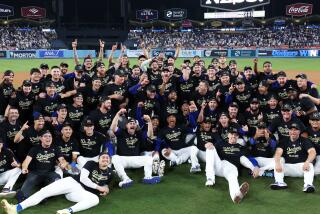Giveaways Costly for the Padres
- Share via
SAN DIEGO — If all I am hearing is going to happen, or not happen, in the Padres’ 1992-93 off-season, I would like to apply for a job as the club’s vice-president/giveaways.
Because of the impoverished state of the Padres’ ownership group, which may be down to its last $500 million, I would handle this chore for free.
You heard it.
Gratis.
I ain’t no greedy reserve infielder.
I don’t want to tip my hand on the whole package, but I have some ideas for giveaways very specific to what the fans might want to maximize their 1993 enjoyment . . .
* Blindfolds.
* Paper bags.
* Clothes pins.
I was even thinking of a Rear View Mirror Night. I would propose giving away rear view mirror holograms with images of Benito Santiago, Tony Fernandez, Bruce Hurst, Randy Myers and maybe even Craig Lefferts. It would obviously have to be a wide angle rear view mirror.
You see, the Padres have a history of giveaways. They turn on the multitudes with giveaways such as beach towels and duffel bags and then turn them off by giving away players. If they give away as many players as they figure to give away this off-season, they may have to give away Toyotas to get any fans to come to the stadium.
They have made what they probably consider to be a shrewd gesture on behalf of their shrinking legions of followers. They have announced that ticket prices will remain the same, except for 2,864 seats on the View Level. These will be lowered by $2.50 each. They should probably consider offering season tickets as Blue Light Specials.
What the Padres have determined is that they cannot make money, or even break even, with the players they have. This is a problem because they players they have were good enough to barely break even at 82-80 in the summer of 1992. You get rid of a handful of these players, namely those with hefty paychecks, and replace them with cheaper (read: inferior) players and you perpetuate a vicious financial cycle.
Having drawn 1.7 million with this year’s players and this year’s record, you wonder what this club will draw with what it seems likely to put on the field in 1993. If this year’s team lost $8.5 million with interesting players having at least an interesting season, it could lose the same amount with cheaper players having a poorer and less interesting season.
Economizing, indeed, may not be fiscally sound.
It’s a little bit like running a restaurant offering prime rib for $14.95, but losing money. The proprietor determines that he can only make money if he substitutes liver and onions for the prime rib and still charges $14.95. He looks around and wonders where the customers have gone.
So the Padres, in the interest of economy, have determined that Santiago will be let go with nothing coming back. This is a little bit like dropping off a Rolls Royce with the Disabled American Veterans. If the Padres keep raising players for the free agent market, maybe they could qualify for a farm subsidy.
Randy Myers will likely leave via the same route, leaving the local heroes with nothing to show for the departed Bip Roberts.
Now the inkling is that shortstop Tony Fernandez and pitcher Bruce Hurst will be traded, thus dispensing with their very substantial salaries. Joe McIlvaine, the general manager, will have to be a miracle worker to get equal value in return for these guys.
Why?
Who in the world would trade a player equal to Fernandez or Hurst but making a substantially smaller salary? If your monthly payments are $500, you’re not going to make a deal which causes you to pay $1,500 for essentially the same quality house.
No way.
What the Padres will be seeking will be affordability, getting the best they can get for the little they want to pay. Maybe McIlvaine can catch a break and steal some young, yet unproven, talent. Others have done it.
Right?
Do the names Shane Mack, Carlos Baerga, Dave Hollins and Thomas Howard ring a bell?
They could, of course, go into the cut-rate free agent market, which netted them a .227-hitting second baseman for $1.75 million a year the last time around. Or they could go into the bargain-basement free agent market, which offers catchers such as Jamie Quirk and Jeff Reed, shortstops such as Jose Uribe and Dale Sveum and pitchers such as Pat Clements, Rich Gossage and Mark Grant, all of whom have been here and done this.
Not much help there, huh?
And it does not look like much help is forthcoming in the immediate future from the minor leagues either.
Those three superstars--Tony Gwynn, Gary Sheffield and Fred McGriff--will be the nucleus of whatever good this team accomplishes in 1993. They may be enough to keep it from being a really bad team, but it would be hard to imagine that they will be enough to make it even what it was in 1992.
The bottom line is that the manager, Jim Riggleman, may not be any smarter than Greg Riddoch or any of his other predecessors, given that a manager’s intelligence rises or falls in direct relation with his players’ talents.
Perhaps Mr. Riggleman might want to be first in line when I distribute paper bags.
More to Read
Go beyond the scoreboard
Get the latest on L.A.'s teams in the daily Sports Report newsletter.
You may occasionally receive promotional content from the Los Angeles Times.










